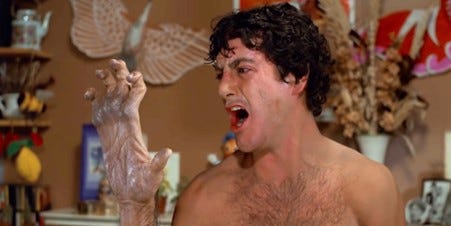Laughing at Lycanthropy – Wallace turns into a Were-Rabbit
Horror Moments, Wallace and Gromit Edition
‘Horror Moments’ is a light-hearted series examining horror-inflected scenes and themes in unexpected places. The ‘moments’ are published weekly on Thursday mornings, and I share bonus content on the history of magic, theatre, storytelling, and more on Monday afternoons – don’t forget to subscribe!
[Spoilers: Wallace & Gromit: The Curse of the Were-Rabbit (2005), American Werewolf in London (1981), Duchess of Malfi (c. 1612)]
Given how horror-literate the first three shorts had been, it’s hardly surprising that Aardman Animation’s first feature-length entry in the Wallace & Gromit series was its most overt horror parody, Wallace and Gromit: The Curse of the Were-Rabbit (2005).
The plot follows the titular pair’s latest business venture, a humane animal control service called ‘Anti-Pesto.’ Disaster strikes when their vegetable-protection products fall victim to a mysterious devouring beast that smashes greenhouses and snatches carrots and courgettes right out of their beds in the middle of the night — just days before the annual Tottington Hall giant vegetable competition!
Creator Nick Park described Were-Rabbit as the ‘world’s first vegetarian horror movie,’ and it is in part a rare guilt-free splatterfest. The townsfolk’s beloved produce is abducted and dispatched in brutal set pieces where beautiful flesh is torn up and consumed — with a death toll of precisely 0.
Oddly enough the soundscape is at times identical to that of a real slasher film, where vegetables have traditionally been used by foley artists to create the sound of snapping bones and ripping skin, as one powerful scene from Berberian Sound Studio (2012) plays out in excruciating length.
But of course the key ‘moment’ from this film is the transformation scene in which we find out who and what has been responsible for all this carnage: Wallace himself, transformed from man to ravening beast.
There are shots here that directly parody the ground-breaking transformation from American Werewolf in London (1981), itself a darkly comic sequence where “Blue Moon” plays over the radio as David’s screams become snarls.
Thinking about this parallel made me wonder whether there has always been something about lycanthropy that lends itself to laughter. Are werewolves (and other were-creatures) always as funny as they are frightening?
Hannah Videen’s wonderful book of Old English beasts The Deor Hoard helps answer the question. “The wulf (wolf), one of these few legitimately dangerous animals, seems to have been universally feared.” Medieval depictions of wolves took them seriously as merciless apex predators, something that has perhaps diminished over time as the human world and the wild have become distanced from one another.
Were-Rabbit pokes fun at the long history of such legends when the creature, ‘carrotus appetitus giganticus,’ is seen illustrated in a medieval woodcut looming over a Christian saint:
By Shakespeare’s day, werewolves were still mostly featuring in frightening or disturbing plots. In John Webster’s brutal revenge drama The Duchess of Malfi (c. 1612) the villainous Ferdinand loses his wits and believes he is, on all levels except physical, a wolf.
Naked and howling, digging up graves, Ferdinand’s transformation could be played for laughs — certainly there is no literal supernatural element here — but the change comes at the culmination of a villain’s descent into insanity. Modern productions are most effective when they take the werewolf motif seriously: Ferdinand’s sadistic, likely incestuous, fixation on his sister has brought about mounting acts of cruelty until his humanity itself has slipped away.
There has been much written on the werewolf as a manifestation of mental illness, or of the destructive aspects of male desire, but none of these interpretations feels ripe for comedy.
It’s worth remembering that American Werewolf itself is ultimately incredibly sad. Its central love story is genuinely romantic and sincere, and the last phone call David makes to his little sister to tell her he loves her always makes me teary. The film expertly balances three genres: horror, comedy, and tragedy.
As we’ve lost our fear of wolves it’s become easier than ever to laugh at the concept of lycanthropy, but there is still always a hint of human pathos in the excesses of monstrous transformation, like a man’s bow tie just visible in the fur of a giant rabbit.
Happy nightmares everyone!
Horror moments are posted every Thursday and a wide variety of articles exploring the history of magic, theatre, storytelling, and more are published on Monday afternoons.












I wanted to say how much I enjoyed your exploration of "The Curse of the Were-Rabbit." Your ability to weave together the film’s humour with a deeper discussion of werewolf mythology was insightful and fun. Your writing always offers a unique perspective—thank you for another great article!
Have you ever read Ursula Le Guin’s wonderful werewolf story (it’s in her anthology The Compass Rose)